| CG-10 | |
|---|---|
 | |
| CG-10A | |
| Role | Transport Glider |
| Designer | Laister-Kauffman |
| First flight | 1943 |
| Primary user | USAAF |
| Number built | 5 |
The Laister-Kauffman CG-10 was an American military transport glider aircraft developed during World War II.
| CG-10 | |
|---|---|
 | |
| CG-10A | |
| Role | Transport Glider |
| Designer | Laister-Kauffman |
| First flight | 1943 |
| Primary user | USAAF |
| Number built | 5 |
The Laister-Kauffman CG-10 was an American military transport glider aircraft developed during World War II.
The development version was known as XCG-10. This version could carry 30 troops. It was accepted on October 4, 1943. The first test tow flight took place on November 6, 1943. The second version, XCG-10A, increased seating capacity to 42 and added a rear loading door. [1] [2] Cargo capacity was up to 6 short tons (5.4 t).
The production version, CG-10A, had an initial order of 990 with the intention of being used for the planned invasion of Japan. 90 were on the production line of St. Louis, Missouri , when the program was cancelled. Laister-Kauffman considered fitting the planes with two Pratt & Whitney R-1830-92 engines but this plan never came to fruition. [2]
Data from Fighting Gliders of World War II, [3] United States Military Aircraft: CG = Transport Glider (1941-1955), [2] Popular Science February 1945 : What's New in Aviation [4]
General characteristics
Performance
Related lists
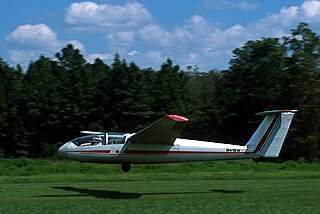
The LET L-23 Super Blaník is a two-seat, all-metal structure glider with fabric covered control surfaces. The aircraft is primarily used for flight training; its single-seat sister model is the Let L-33 Solo.

The Schweizer SGS 2-33 is an American two-seat, high-wing, strut-braced, training glider that was built by Schweizer Aircraft of Elmira, New York.
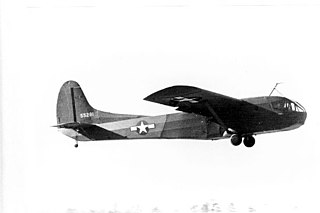
The Waco CG-15 was an American military glider, which was developed from the CG-4. Although outwardly similar to its predecessor and carrying the same number of passengers, a number of changes in the design, including shortened wings and a more streamlined nose enabled it to travel faster. 1,000 were ordered and 473 were delivered before production ceased. Two were transferred to the Navy for testing as the XLR2W-1. One unit was converted into an XPG-3 powered glider which used two Jacobs R-755-9 radial engines.
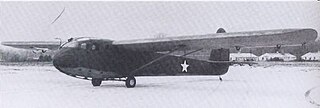
The Waco CG-3A was a United States light troop military glider of World War II.

The Waco CG-4 was the most widely used American troop/cargo military glider of World War II. It was designated the CG-4A by the United States Army Air Forces, and given the service name Hadrian by the British.
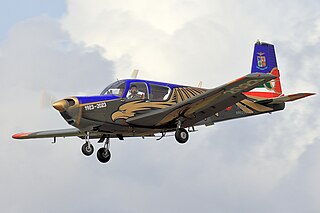
The SIAI-Marchetti S.205 is an Italian four-seat, single-engine, light airplane, manufactured by SIAI-Marchetti. The S.205 made its maiden flight in 1965. The Italian Air Force employs a version called S.208.

The Chase XCG-18A and YC-122 Avitruc was a military transport aircraft designed by Chase Aircraft and produced in limited numbers in the United States in the late 1940s, initially as a glider, but definitively in powered form. The design was based on the CG-14 cargo glider but was substantially larger and featured all-metal construction. It was a high-wing cantilever monoplane. The fuselage was of rectangular cross-section and featured a loading ramp at its rear. The main undercarriage units were carried at the sides of the fuselage and were fixed, while the nosewheel was retractable. In its powered form, two radial engines were fitted in nacelles in the wings.

The Douglas XCG-17 was an American assault glider, developed by the conversion of a C-47 Skytrain twin-engine transport during World War II. Although the XCG-17 was successfully tested, the requirement for such a large glider had passed, and no further examples of the type were built; one additional C-47, however, was converted in the field to glider configuration briefly during 1946 for evaluation, but was quickly reconverted to powered configuration.

The Waco CG-13 was an American military transport glider aircraft developed during World War II.

The Laister-Kauffmann TG-4 is a sailplane produced in the United States during the Second World War for training cargo glider pilots. It was a conventional sailplane design with a fuselage of steel tube construction and wooden wings and tail, covered all over with fabric. The pilot and instructor sat in tandem under a long canopy.
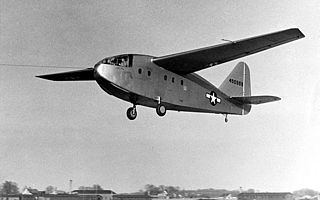
The Chase CG-14, also known as the G-14 or Model MS.1, was an assault glider manufactured by Chase Aircraft for the United States Army Air Forces during the Second World War. The aircraft failed to progress beyond the prototype stage, being overtaken by larger, improved glider designs.
The Laister LP-46 and LP-49 are a family of American high-wing, single-seat, gliders that were designed by Jack Laister and produced by Laister Sailplanes both as kit aircraft and as certified complete aircraft.

The Midwest MU-1 was an American single-seat, high-wing, strut-braced utility glider that was designed by Arthur B. Schultz in the 1930s.
The Broburn Wanderlust was a small, wooden, single-seat glider designed in the United Kingdom just after World War II. Only one was built, though it was well used.
The Leffler-MacFarlane LM-1 is an American mid-wing, single-seat, FAI Open Class glider that was designed and constructed by Al Leffler, Walt MacFarlane and Bill Meyer, first flying in November 1963.

The Antonov A-15 is a Soviet mid-wing, V-tailed single-seat, FAI Open Class glider that was designed by Oleg Antonov and produced by Antonov.

The Wassmer WA-30 Bijave is a French two-seat advanced training glider designed and built by Wassmer Aviation of Issoire.
The Bowlus CG-8 was a prototype Second World War American transport glider to be built for United States Army, one was built but the type did not enter production and the programme was cancelled.
The Bowlus CG-7 was a prototype Second World War American transport glider to be built for United States Army, one was built but the type did not enter production and the programme was cancelled.
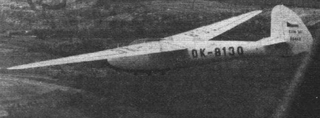
The Zlín Šohaj series of club gliders began as a post World War II development of the DFS Olympia Meise. A large number were built in the 1940s and '50s.